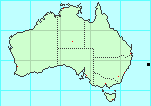 The eggs are dropped with the frass, as is common for most stick insects.
The eggs are dropped with the frass, as is common for most stick insects.

This is a shiny, heavy-bodied, reddish brown, wingless species, the male having enormously thickened hind femora with a few heavy spines beneath (Gurney 1947). It was formerly very abundant on Lord Howe Island, where it fequented large cavities in the trunks of living trees, coming out at night to feed.
(female) - Head with a shallow, oblique sulcus extending mesioposteriorly from posterior margin of each antennal socket; two punctures on dorsum mesially, slightly posterior to hind margin of eyes; antenna reaching about to middle of mesonotum. Pronotum with posteriorly convex transverse sulcus in front of middle; mesonotum and metanotum sparsely punctate; carinae of front and middle femora obsolete, of hind femur weakly developed, serrate; tarsi rounded dorsally; tarsal segment 5 subequal to segments 1-4 combined. Apical tergum short, narrowly rounded posteriorly, almost conelike in dorsal view; ovipositor sheath with about one-fourth length extending posterior to apex of last tergum, apical third gently, gradually curving dorsad, apex acute; cerci leaflike, projecting ventroposteriorly, laterad of ovipositor sheath.
Coloration: General color dark reddish brown, a blackish tinge on head and thorax; mesosternum and membranous coxal areas pale.
(length): Body, 120 mm.; front femur, 18 mm.; hind femur, 23 mm.; hind tibia, 18 mm.; pronotum, 12 mm.; mesonotum, 22 mm.; ovipositor sheath, 24 mm.
Male - Differing from female as follows: Tuberculation of mesopleuron and spination of metapleuron more developed; carinae of front and middle femora weak. Hind femur with dorsal, lateral carinae each bearing 6-12 serrations, mostly in basal third; internal ventral carina with about 5 teeth, increasing in size distally; about 8 small teeth along median ventral line, the largest midway of the length; external carina with 2 heavy, conspicuous teeth in apical half, the basal nearly twice as long as apical one, basal half of carina with 2 or 3 serrations. Hind tibia very arcuate, deeply sulcate dorsally in apical half; a median, irregularly notched ventral carina, bluntly toothed apically. Abdomen narrower and less tapering than in female; apical tergum nearly truncate, narrowly divided along middorsal line in apical half, the lateroapical angles somewhat extended posteriorly, broadly rounded; cerci thin, leaflike, extending ventroposteriorly; apical sternum blunt, feebly emarginate.
Coloration: Thorax nearly black; posterior margins of most body segments yellow.
Measurements (length): Body, 106 mm.; front femur, 18 mm.; hind femur, 32 mm.; front tibia, 16 mm.; hind tibia, 20 mm.; pronotum, 12 mm.; mesonotum, 21.5 mm.
 The eggs are dropped with the frass, as is common for most stick insects.
The eggs are dropped with the frass, as is common for most stick insects.
The eggs were beige in colour with a raised, reticulate pattern. The micropylar plate was teardrop shaped and the capitulum of the operculum was circular with a rim facing anteriorly. (Priddel et al 2003)
Note typical vegetation, e.g. tropical rainforest, temperate rainforest, grasslands, alpine, etc.
For a stick insect with body length 120mm, to keep 2 adult females, you need a cage at least 550mm high, 250mm deep and 250mm wide.
 Range:
Range: This species was unusually common on Lord Howe Island until rats were introduced. It seems unlikely that a rat could subdue an adult of a formidable creature such as this. Perhaps their depredations were directed at eggs and nymphs. Photographs exist documenting the large numbers of these insects in banyan trees on Lord Howe. The very trees in which they lived still exist there, but there is no trace of the stick insects.
|
Copyright © 2000-2003
Peter Miller
This page was last changed 20-Sep-2006. |

|

|